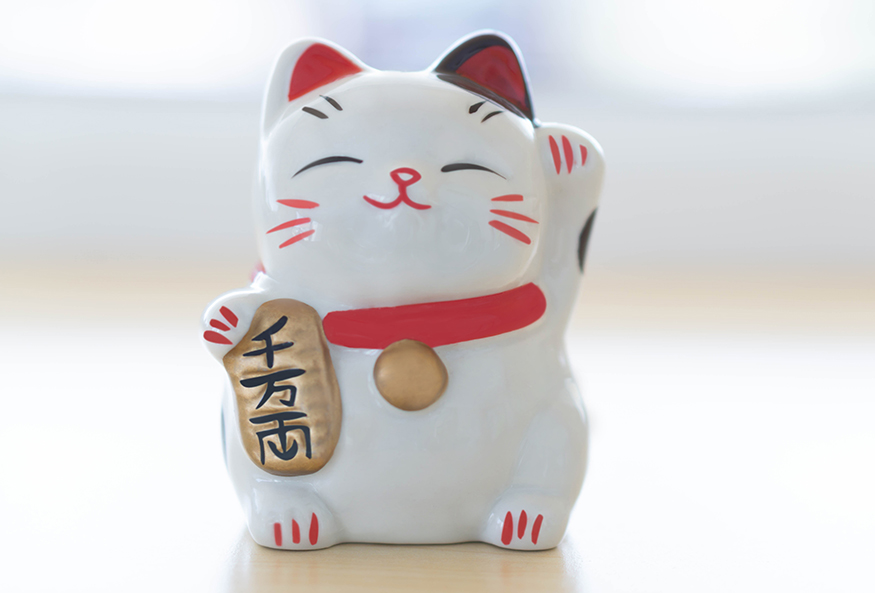When walking through Japanese shrines, shops, or even train stations, it is easy to notice colorful charms, round-faced dolls, or cat figurines beckoning with raised paws. These are engimono (縁起物)—traditional good-luck items believed to bring prosperity, health, or happiness. Rooted in centuries of folklore and spirituality, engimono remain an integral part of Japanese life, bridging the gap between past and present. From maneki-neko (beckoning cats) and daruma dolls to hamaya (ritual arrows), these symbols carry deep cultural meanings while continuing to find modern relevance.
Lucky Charms of Everyday Life
Engimono are often seen as small but powerful objects, each embodying hopes for specific blessings.
- Maneki-neko (招き猫): With one paw raised, these “beckoning cats” are believed to invite fortune. A raised left paw is thought to attract customers, while a raised right paw invites wealth. They are often placed at restaurant entrances or shop counters, greeting visitors with a cheerful wave.
- Daruma (達磨): These round, red dolls are modeled after Bodhidharma, the founder of Zen Buddhism. Purchased with blank eyes, one eye is filled in when setting a goal, and the other upon achieving it. Daruma thus represent perseverance and resilience, encouraging people not to give up.
- Hamaya (破魔矢): Literally “demon-breaking arrows,” these symbolic arrows are sold at shrines during the New Year. Families place them in their homes to ward off misfortune and welcome good fortune for the coming year.
Each of these items is more than decoration—they embody a sense of protection, motivation, and optimism that accompanies daily life in Japan.
Cultural Roots and Symbolism
The significance of engimono lies in their fusion of Shintō, Buddhist, and folk traditions. Maneki-neko originated in Edo-period temples, where legends spoke of cats saving travelers or attracting prosperity. Daruma dolls symbolize the spirit of “fall seven times, stand up eight” (七転び八起き), reflecting Buddhist teachings of resilience. Hamaya’s protective power links back to shrine rituals where arrows symbolized purity and the ability to pierce through evil.
These stories give engimono their lasting resonance. They are not just souvenirs but cultural anchors, reminding people of values like perseverance, community, and reverence for unseen forces. Their presence in households, businesses, and festivals reflects Japan’s continued respect for symbolic traditions.
Engimono in the Modern World
Though rooted in history, engimono remain relevant in contemporary Japan. Shops sell daruma in a rainbow of colors, each representing a different wish—gold for wealth, pink for love, green for health. Maneki-neko have been adapted into everything from neon-lit advertisements to smartphone charms. Hamaya continue to be purchased at shrines every New Year, but modern households also display them alongside digital gadgets and minimalist interiors.
Beyond Japan, engimono have gained international popularity. Maneki-neko can be found in restaurants across Asia, Europe, and the United States, often rebranded as “lucky cats.” Daruma dolls are used by athletes, politicians, and students worldwide as motivational icons. This global presence highlights how Japanese traditions, while deeply local, also speak to universal human hopes.
A Living Tradition of Hope
At their core, engimono symbolize the universal desire for good fortune, protection, and achievement. They illustrate how Japanese culture weaves spirituality into everyday objects, turning simple items into vessels of meaning. Whether placed at a shop’s entrance, a family’s altar, or a student’s desk, these good-luck charms continue to inspire resilience, positivity, and connection.
For learners of Japanese culture, exploring engimono is more than studying lucky objects—it is a journey into how people express faith, hope, and gratitude through artful tradition. Like small beacons of light, these charms remind us that even in uncertain times, humans everywhere reach for symbols of comfort and optimism.











